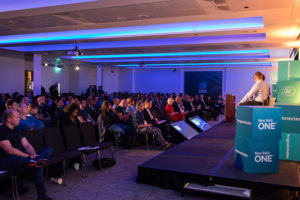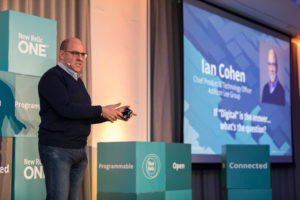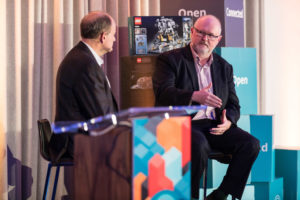New Relic’s recent FutureStack London event relied on a formula for success that will sound familiar to attendees at last year’s event: Put customers—and their stories—front and center. In fact, almost every session at FutureStack London featured top practitioners offering a first-person perspective on using modern software development methods and tools to stay competitive and relevant, to drive innovation, and to solve their customer experience challenges.
One event, many stories
In some ways, this year’s London event followed the blueprint used at previous FutureStack events in New York, as well as in Sydney and Melbourne—for example, opening with a keynote offering a guided tour through New Relic’s major new product announcements. (View the FutureStack New York keynote here, and check out our blog to learn more about the new capabilities unveiled for New Relic One.)
When the FutureStack program turned to the first of its customer-driven sessions, however, it became clear why New Relic’s London events have established themselves as a unique and distinctive forum for sharing and learning from customer conversations. And the companies featured at FutureStack London this year didn't disappoint, covering a vast range of business challenges and contexts—from established consumer brands like Domino’s Pizza to cloud-native, disruptive newcomers like Picnic; and from digital business service providers like Wix to major manufacturing players like MAN Truck & Bus.
Learning to work in an unpredictable world
It's also important to recognize that in spite of their differences, the companies telling their stories at FutureStack London also share common business challenges and marketplace realities. Another featured speaker at FutureStack London, Addison Lee CTO Ian Cohen, did an excellent job of describing one of the most important of these shared challenges: a profound, long-term shift away from predictable and relatively stable business models; and the emergence of a business environment defined by unpredictability, sudden change, and a dynamic competitive landscape.

When we talk about concepts like "digital transformation" as the answer to modern business technology problems, Cohen told the FutureStack audience, it's important to understand the question: How can firms adapt, survive, and thrive in this unfamiliar—and often disconcerting—new reality? "In the past, we focused on consistency and reliability … but then the world changed," Cohen said. "We became a world dominated by data, and insight, and technology.”
“Suddenly, the world was not about how big you could be—it was about how fast you could be—how quickly you could adapt and evolve your products and services,” Cohen said. By understanding the impact of this change, he told the audience, it can be much easier to understand the value of digital business capabilities for addressing it.
Two customer stories from FutureStack London exemplify what this emphasis on speed and agility can mean to a modern business. One involves an established brand striving to stay ahead of relentless expectations; the other features a classic case of a startup disrupting a market dominated by much bigger competitors.
Domino’s Pizza: still feeling the need for speed
For one Domino’s Pizza, the need for speed is a familiar demand—one the company famously addressed with its 30-minute delivery guarantee. And according to Barry Wiech, CIO of Domino’s Pizza UK, the company has also long embraced digital solutions to its operational and logistical challenges.
Over the past several years, however, Wiech noted that the rapid growth of Domino’s digital channels had pushed the demands on its legacy systems to unprecedented levels For example, Wiech confirmed that about 70% of Domino’s $1.42 billion in annual sales happens during just three days of the week—including, in some cases, peak sales that can approach $1.2 million in a single hour.

“That’s where the cloud is a strength,” he noted. “The cloud gives you the ability to scale quite quickly … giving us the ability to get rid of quite a lot of capacity overhead” that Domino’s had previously (and at great expense) maintained to deal with these types of massive, yet relatively infrequent, surges in demand.
Yet Wiech acknowledged that the biggest cloud adoption challenges for Domino’s actually involve people and processes, rather than technology. “I’m not worried about the technology part, if I’m being completely honest,” he noted. “It’s been done before.” Instead, Wiech said he’s more concerned about preparing his team to embrace the mindset associated with a DevOps culture. “It’s about getting the team to embrace a new way of thinking around technology … today, it really is about ‘get it out, and get it out now, and get it out fast’ and about giving them the tools and empowerment to make that work.”
Customer experience is another major concern in an industry where expectations run high and loyalties can be fickle. According to Wiech, New Relic plays a critical role in detecting and addressing performance issues—no matter where they originate in the stack—before they impact the customer experience. New Relic also helps Domino’s to decide where and how to prioritize software performance improvements.
“Performance correlates to conversions” for Domino’s, Wiech stated. “If you take your eye off the ball, [consumers] are actually changing their behavior” in real time when performance issues affect the Domino's digital experience, which makes it absolutely critical for the company to understand and get to the source of problems quickly. And in many cases, he noted, New Relic has helped the Domino's team recognize that the most impactful performance issues aren’t always the most obvious ones: “Where you may not have focused on performance in an area because of low utilization, sometimes [New Relic] can tell you—if you focus there, you will see some improvement.”
Picnic: delivering disruption to the grocery industry
Picnic, an online supermarket based in the Netherlands, offers a great example of the value New Relic creates for young, fast-growing, born-in-the-cloud businesses. Picnic’s business model, which targets middle-income consumers with competitive pricing and no delivery charges, has been wildly successful—capturing a 10% market share since its launch in 2015.

In order to build a viable business, however, Picnic’s founders recognized that efficiency would be a do-or-die objective. To that end, according to Picnic Tech Lead Philip Leonard, the company maintains end-to-end control over its supply chain, from national distribution centers to a fleet of electric-powered delivery vans. Picnic also turned to New Relic One, the industry’s first fully programmable observability platform, to gain unique insights into its business performance and efficiency.
“Forecasting accuracy is everything for Picnic,” Leonard stated, referring to the company’s delicate balance between optimizing its inventory and meeting consumer demand. The company used the programmability of New Relic One to build a custom dashboard showing forecasting efficiency for each of its main distribution centers. By surfacing this performance data in a clear and intuitive way, he said, Picnic “can identify where we made a mistake with forecasting … or whether a supplier has a broader issue with their ability to fulfill our orders.”
Previously, Leonard noted, “this data was available to analysts within the company,” but getting it usually involved significant lag time—and thus potentially significant delays addressing forecasting issues. Today, by comparison, “We’re taking what [analysts] are already used to—but then plotting it in real time.”
The New Relic One approach to programmability, Leonard stated, also gave the company a far more efficient and flexible path to getting value from its development process: “As a back-end developer, it was kind of liberating to be given a programming space to create a dashboard.”
In addition, Leonard pointed out, “It was super simple to dive in and deliver business value” by leveraging existing components” shared by other developers and licensed as open-source code. “You don’t have to reinvent the wheel,” he said. “You can take an open-source example that someone else has developed, and tweak it to your exact needs."
The views expressed on this blog are those of the author and do not necessarily reflect the views of New Relic. Any solutions offered by the author are environment-specific and not part of the commercial solutions or support offered by New Relic. Please join us exclusively at the Explorers Hub (discuss.newrelic.com) for questions and support related to this blog post. This blog may contain links to content on third-party sites. By providing such links, New Relic does not adopt, guarantee, approve or endorse the information, views or products available on such sites.


